Intrigued by Timor-Leste? Want to discover its friendly capital, historic fort, and scenic mountain villages? Timor-Leste – Why Go and Things to Know is our personal experience exploring this country in 2024. Our adventure includes Dili, Balibo, Maubisse, Aileu and Atauro Island. We share our insights on where to stay, where to eat and drink, and things to see and do. Timor-Leste – Why Go and Things to Know reflects our travel style and aims to provide useful things to know before visiting this obscure destination.
Timor-Leste, ‘explore the undiscovered.’ One of the least visited countries in the world, there certainly is an undiscovered feel about it. With twenty-five years of occupation and conflict finally ending in 2002, and the struggle continuing for a number of years after independence, Timor-Leste had more things to worry about than tourism. But the country is now finding its feet, time is slowly healing old wounds. The focus is shifting from recovery, to a reinvention type phase. Timor-Leste’s natural beauty and attractions are beginning to take centre stage. The government is investing in tourism, with infrastructure beginning to be repaired. Shops and cafes are appearing and flight routes are increasing. People are starting to arrive. Timor-Leste has begun to recognise its potential. Travel here isn’t easy, that’s part of the attraction. But things are becoming easier, the undiscovered is being discovered.
Why go to Timor-Leste?
To discover the undiscovered of course. With the rest of South East Asia well-trodden and often crammed with visitors, Timor-Leste provides a great alternative for travellers seeking a bit more adventure and something new. Well known by divers in the past, people are beginning to realise that the country has much more to offer. Improving infrastructure is making previously inaccessible areas easier to reach and explore. History is both tragic and interesting, pristine beaches are deserted and highlands are laden with coffee and mangoes. Forts, waterfalls, welcoming people and offshore islands make Timor-Leste a rewarding and memorable destination for the curious and intrepid traveller.
- Capital: Dili
- Best time to visit: May – Nov (wet season is Dec to April)
- Budget/Mid-Range/Couple: AU$130 per day
- Currency: US dollar (US$1 = AU$0.65)
- Language: Tetum
- Visa: Yes
- Difficulty: 3 (1-basic & 5-challenging)
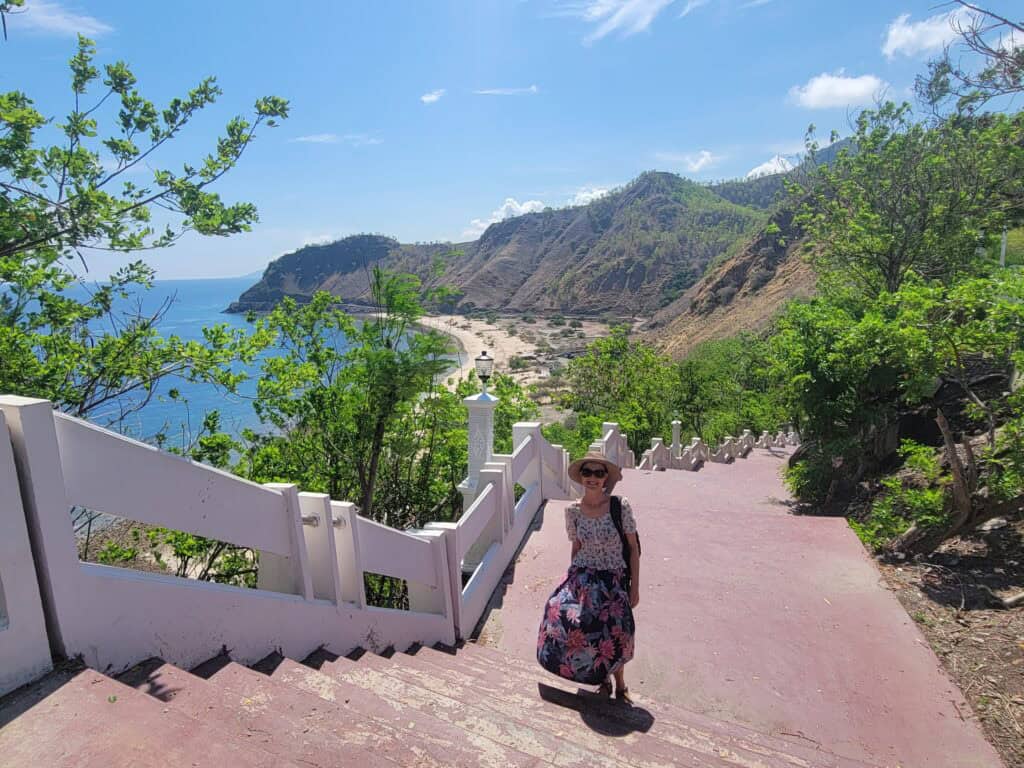
Dili
Dili is a city that will grow on you. It’s a friendly place, welcoming, with the people, and what seems like the city itself, happy to see you. Sitting on the waterfront, facing North, and surrounded by hills, it gets hot. Giant trees line the streets, providing some respite from the relentless sun. A promenade runs the length of the city, hugging the bay, and is full of parks, picnic spots, and shade. Men sell fresh coconuts, locals socialise, children play. Colourful microlets, the main form of public transport, navigate the busy streets. Old colonial buildings add to the atmosphere. It’s hot, but it’s also very chilled.
Getting to Dili
With only a few current flight connections, getting to Dili doesn’t require much imagination. Flights from Darwin, Denpasar and Singapore are the only current options, but with Melbourne about to start a direct flight, and other routes planned, getting here will become easier. The airport is a short fifteen-minute ride out of town, with local van number ten running straight past the airport into the city centre. Reaching Dili by bus from Kupang, in neighbouring Indonesia is also possible,
Where to stay in Dili
Accommodation in Dili is on the expensive side. Budget and midrange establishments are limited, and tend to be overpriced. US$50 per night for basic lodgings is considered a great deal. Airbnb is not yet popular, with guesthouse style places being your best bet. Many places will say Wi-fi, TV, and free breakfast, but don’t count on it. These services will be broken or not available. Even the fancier hotels will have unreliable and slow internet. Dili is a small city, with cheap and regular public transport, which means anywhere you manage to find a place will be convenient.
Where to eat and drink in Dili
Dili is full of local style restaurants, fried chicken and beef being the main dishes. Rice and beans can be purchased on the streets and in the parks, wrapped in a pyramid shaped paper bundle. Restaurants catering for visitors are growing in number, and there’s also a busy food court at the Timor Plaza. Fresh fruit and vegetables are sold at the market on the waterfront, while refreshing coconuts are offered all over the city. There’s no shortage of quality grocery stores.
- Get to Dilicious Timor (Great prices, staff, and dishes. Our favourite was the eggplant curry. Visitors and locals dine here. Staff speak English, and you can pay by card)
- Don’t miss Mehi Cafe (a community project, violence against women, they make cakes, chocolate and ice-cream. Theres also a restaurant, which trains abused women to become chefs. An amazing place. Don’t miss the coconut ice block)
- Check out Queen Tanduri Restaurant (a local Indian style restaurant, with super friendly staff, and loads of vegetarian options. The samosas are great)
Things to see and do in Dili
Resistance Museum An excellent museum explaining the history of Timor-Leste, from the struggles with the Portuguese, the Indonesian invasion, and fight for independence. A lot of information, with displays in a number of languages, including English.
Chega Museum is located in an old prison used by the Indonesians. Displays and stories of former prisoners and freedom fighters paint a horrific picture, but give you an idea of the atrocities that the country has endured in the past. You can see the old cells and various isolation chambers. The memorial garden in the courtyard commemorates some of those who were lost, but will never be forgotten.
Cristo Rei watches over Dili, and is visible from most places around the city. Catch microlet number 12 from the city out to the base of the hill, then climb the five hundred or so steps to reach the viewing area at the top. Great views of the city, and down the coast.
Immerse yourself with the locals on the waterfront, under one of the many ancient trees. Grab a fresh coconut, or a bundle of rice, and watch life go by.
Local initiatives such as the Alola Foundation, Agora Food Studio, and Pro-Ema Restaurant School are excellent causes. Visiting and chatting to the lovely ladies is both fun and rewarding, not only for you, but the women also.
Tais Market is the best spot to find local handmade crafts. Loads of colourful bags and blankets, woven from a textile found on the island called ‘tais’.
Cafes selling locally grown coffee and products are appearing on the scene all over the country. Dili is a coffee lover’s dream. The coffee and products are organic and inexpensive. Aroma Café was a favourite.
DARE Café and museum is where you will find the best views of Dili. The small museum explains Timor-Leste’s involvement in WW2, while the café serves coffee and pizza. The soursop juice is excellent. To get here, jump on the back of a motorbike taxi at the bottom of the hill.
Taibessi Market is the city’s biggest local produce market, where you will find goods from all over the country. Check it out and chat to some of the locals. Microlet’s 4,5,7 and 8 come here from the city centre.
Getting around Dili
You can walk to most places. Local microlets are super cheap, regular, and easy to flag down. They pick you up when you wave, and drop you when you tap your coin on the handrail. They run on set routes, and each microlet has a number. Once you are familiar with the route number, it’s easy. Regular taxis drive around honking their horns. Agree on the price before you get in.
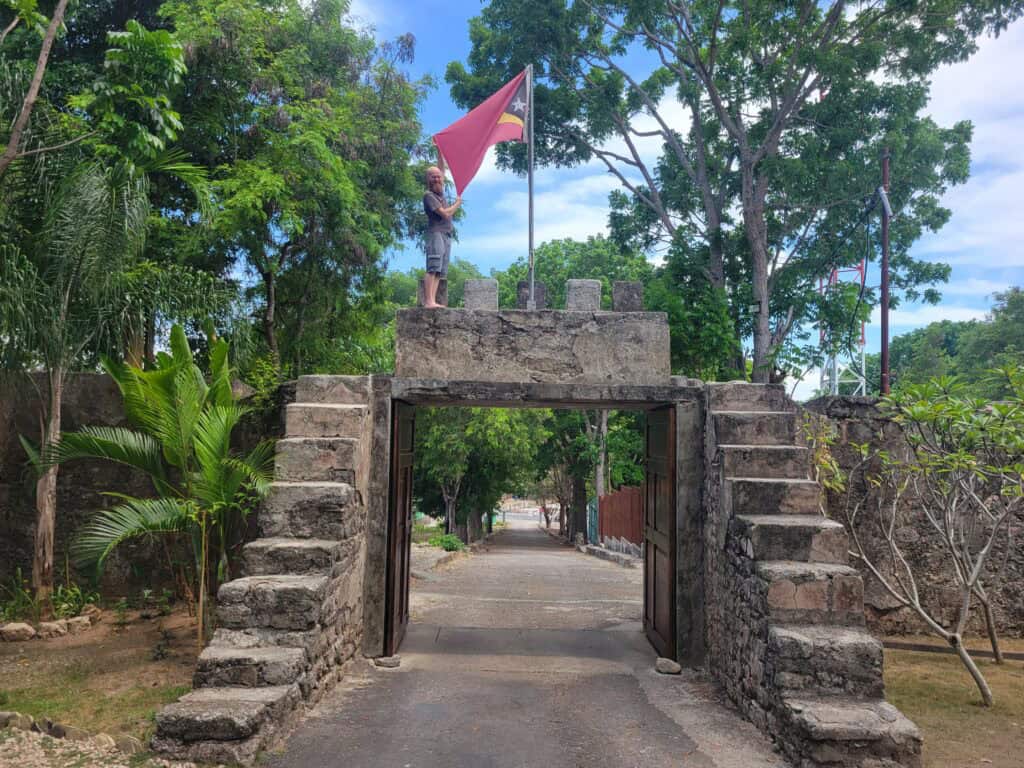
Balibo
Balibo is the country’s most historical and well-known town. Located in the hills, only a short distance from the Indonesian border, it holds a strategic position. A fort was constructed here by the Portuguese, and it has seen plenty of action over the years. Now a hotel and museum, it’s the main reason people visit the town. Nearby is also where five international journalists were brutally murdered whilst covering the invasion, with a small museum now telling the story of the Balibo five. Balibo village itself is small, with very limited supplies. It’s a friendly place, and cools down in the evenings.
Getting to Balibo
Colourful buses, or small trucks with bench seats on the back, are used as public transport to towns outside of the city. The Balibo bus leaves early each morning, from the Tasi Tolu Terminal, on the main road out past the airport. It’s more of an open field than a bus terminal. Get there early, the earlier the better, around 7am. The ride takes around four hours. The local price is US$6, but being a foreigner means you may have a ‘tax’. The best thing to do is jump on with everyone else, don’t ask what the cost is, just act like you know what’s going on. The bus back form Balibo to Dili leaves around 8am each morning from near the market.
Where to stay in Balibo
Balibo Fort Hotel is one of the only places in the village. Rooms are spacious and comfortable. There are great views, a pool, and a restaurant. The staff will go out of their way to help you. Local homestays are sometimes available, but arranging things can be difficult.
Where to eat and drink in Balibo
A small village with very limited options. Grocery stores are basic. There’s a morning market, where women sell vegetables. You may find someone selling cooked rice, and fried chicken, depending on the time of day. We couldn’t find any fruit in the village. Balibo Fort Restaurant is where nearly all visitors eat.
- Get to Zulmijon Restaurant (the only place we could find. Super friendly family run place. Basic meals. No menu)
- Don’t miss Balibo Fort Restaurant (move your table out onto the lawn and enjoy the sunset)
- Check out The Local Market (under the huge tree, you can’t miss it)
Things to see and do in Balibo
Balibo Veterans Museum is well set up and contains a wealth of information. You will learn a lot about the history of Timor-Leste and their relationship with Australia and New Zealand. Amazing place.
Balibo Fort is in pretty good shape, and you can still clamber up the walls. Original cannons sit around the front, near the restaurant.
Balibo Five Museum is an excellent community centre, which doubles as a museum. Staff will happily explain things, and give you a short tour of the centre, including the dental clinic and gift shop. Really helpful, and will answer any questions. Renting a scooter is sometimes possible.
Balibo Walking Tours is a few buildings down, and offer a variety of different services, from guided walks to nearby caves and waterfalls, to push bike hire.
Immerse yourself in everyday village life. Take a walk through the market, and around the streets. Chat to people, see how they live, and get an understanding of what it’s like to live here, and how difficult it must have been during the invasion and following years of struggle. They’re a really loving and welcoming community.
Getting around Balibo
All you need is within easy walking distance. The staff at the hotel or museum will happily arrange a scooter ride to places out of town, such as the waterfall, or even the Indonesian border.
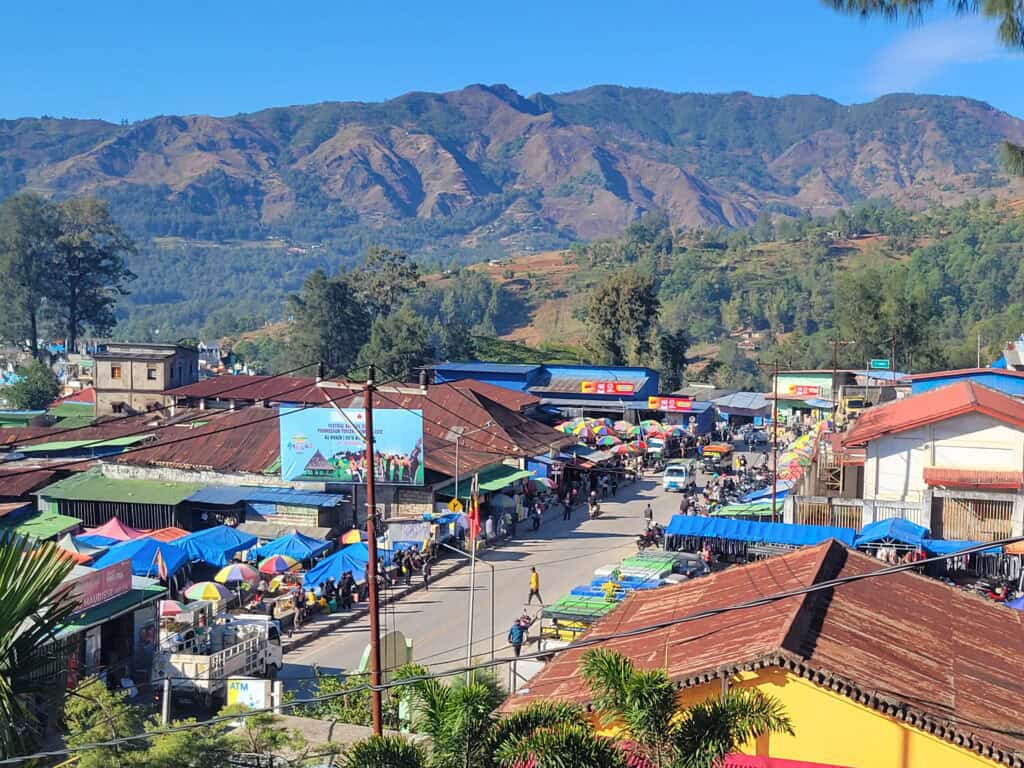
Maubisse and Aileu
These neighbouring towns in the central highlands are a refreshing change of scenery from busy Dili. Coffee is the theme in this area of the country, with some of Timor’s best grown in the hills and valleys surrounding the towns. Vanilla, strawberries and mangoes are also popular crops, with farm stays and visits to plantations some of the activities on offer. Community based projects, co-ops and women led ventures make it a worthwhile and interesting region to spend a few days or more.
Getting to Maubisse and Aileu
Inland from Dili, public transport leaves from the Taibesi Bus Station. Microlet numbers 4,5,7,8 all go to the station from the city centre. Small trucks which carry passengers leave when full, with the trip to Aileu taking just over an hour. Maubisse is another hour away. Locals pay US$4. The road is in good condition, and is a self-drive option, if you are willing to splash US$100 per day to hire a car. A growing number of tour operators in Dili offer day trips here.
Where to stay in Maubisse and Aileu
Staying in a guesthouse, and supporting a local family, is a great and worthwhile experience. Maubisse has a handful of options, in town and on nearby farms. We stayed at Guesthouse Sara, which doubles as a busy restaurant and coffee shop. Rooms are basic. There’s plenty of options around town, but don’t expect five-star luxury. Aileu has a variety of accommodation, from guesthouses, to farm stays and camping. Finding a place that supports a good local cause is a great idea. We stayed at Projeto Montanha, which trains local youth. It was one of the nicest places we stayed in Timor-Leste.
Where to eat and drink in Maubisse and Aileu
Local style eateries are easy to find, as is fresh local coffee. Cafes and restaurants making meals from fresh locally grown produce are growing in number, selling lovely homemade dishes. We also enjoyed finding fruit at the local markets.
- Check out Sara Guest House & Restaurant (nice beans and rice plate or snacks)
- Get to Projeto Montanha (wholesome homemade meals. All ingredients are either grown in their garden, or found locally. Food is made by local youths who are training to work in the industry. Tasty guava juice)
- Don’t miss Aileu Coffeeshop (great coffee. 2022 national coffee champions. Run by local youths)
Things to see and do in Maubisse and Aileu
The Old Posada in Maubisse is slowly being restored. There are great views. Short walk from town.
Immerse yourself in the Local Markets. Thursdays and Sundays are the main days in Maubisse, Wednesday and Saturday in Aileu, with people coming from all around to sell whatever it is they have to offer. People are friendly. Take your time and have a chat. It’s an enjoyable atmosphere.
Dili Vanilli offers tours of their vanilla farm. There’s a small shop selling local coffee and spices, a café, and they also have accommodation and camping facilities.
Waterfalls and Caves are located in the area, with plenty of guesthouses offering tours to visit them.
Local Plantations and farms offer visits, which most guesthouses can arrange. Coffee production is the main one.
Getting around Maubisse and Aileu
Maubisse and Aileu, like any small town, are best navigated on foot. Taking the time to walk, meeting locals, and seeing how they live is one of the main reasons we travel. Some of our favourite Timor-Leste memories are from our time spent walking. Public transport stations are nearly always near the market. The destination is displayed on the front windscreen, and the driver will confirm where he’s heading. Transport heads further inland towards the coast, or back to Dili.
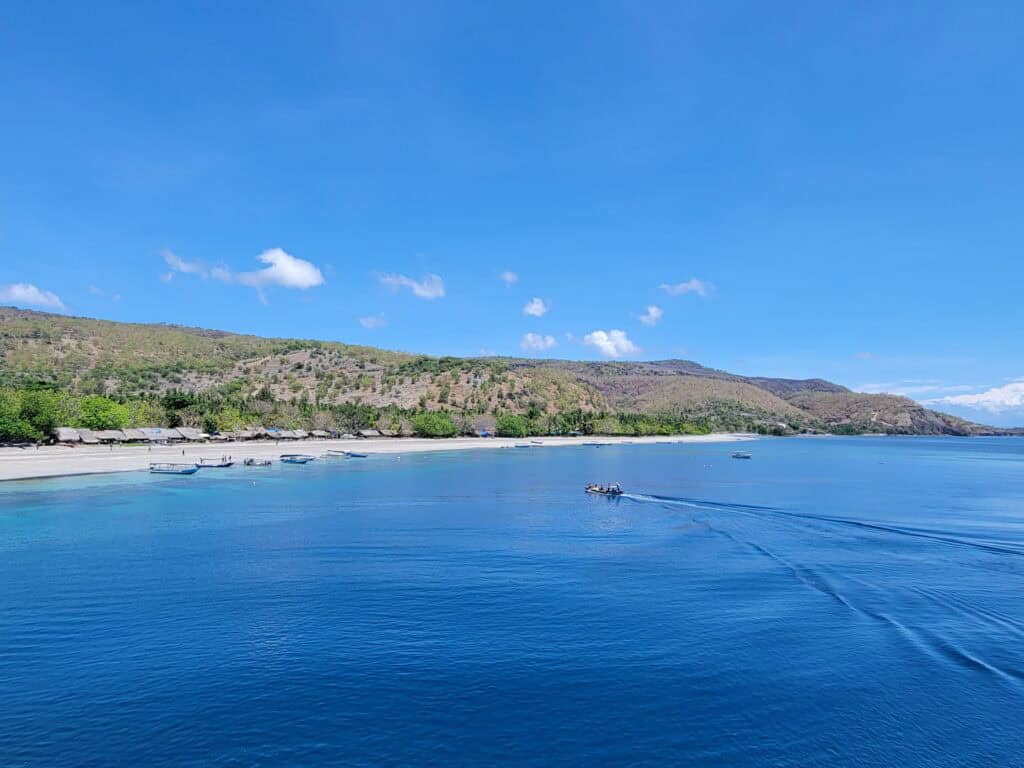
Atauro Island
Atauro island lies off the coast of Dili. With crystal clear waters, it’s popular with divers and marine biologists. Life here is simple, with the ocean providing the main source of food, as it traditionally always has. Small villages cling to the coast, with the interior steep and hot. Slow and easy is the theme out here.
Getting to Atauro Island
Two ferries make the trip from Dili. The Dragon Fly is the quickest, taking an hour. Departures are on Thursdays and Saturdays at 8am, with the ferry returning at 2pm. The Success Ferry makes the crossing on Tuesdays and Saturdays, and takes three hours. It departs at 8am also, and returns at 2pm. Tickets can be purchased from the office next to Gloria Jeans café. Water taxis can also be hired if you are after a private trip.
Where to stay in Atauro Island
Accommodation on the island is limited to a couple of dive resorts, with Barry’s Place the usual choice. Local guesthouses are available in the two main villages, Beloi and Vila. These are basic rooms with a fan, with hosts providing some meals. English is limited, and making a reservation is best done over the phone. Ask your host in Dili if they can call and make a booking for you.
Where to eat and drink in Atauro Island
Rice and fish dominate the menu. Local style eateries serving rice and fish line the beach. Ladies sell fruit and vegetables in the small village markets. Theres a limited grocery store.
- Get to Barrys Place (the only Western type eating option on the island. Meals are served buffet style. Non-guests are welcome. Plenty of vegan and vegetarian dishes)
- Don’t miss Fresh Coconuts (best way to hydrate after exploring the village. Ladies sell them on the beach)
- Check out A Local Eatery (they line the beach. Grab a small package, which contains coconut rice, and then add some fish or a vegetable from one of the containers on the table)
Things to see and do in Atauro Island
Whale Watching This is the reason people come to Atauro island from all over the world.
Diving or Snorkelling is the number one pastime, with clear water and abundant marine life.
Hiking to caves and local traditional villages during the cooler months is interesting, with local guides easy to find.
Immerse yourself in local life by interacting with islanders at the village markets, or in the streets away from the busy beach. People are friendly and approachable.
Getting around Atauro Island
Small trucks wait at the station next to the ferry port. They head to all parts of the island. The island only has one main road. The main village Beloi is very small, and easily discovered on foot.
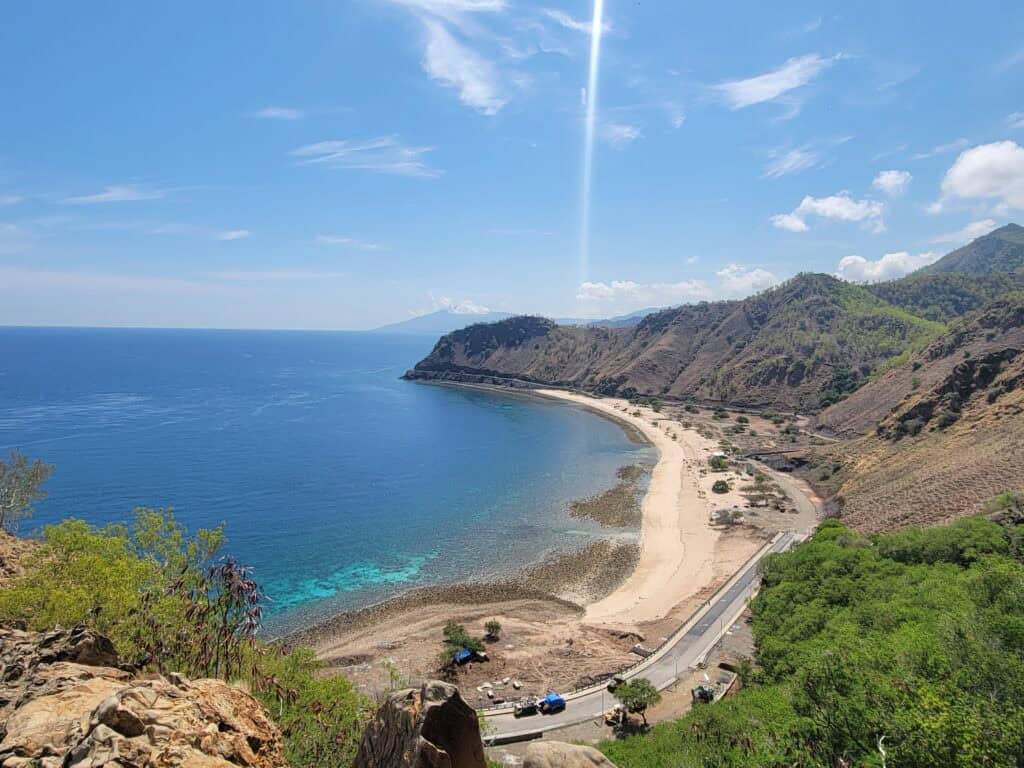
Getting to Timor-Leste
Flights from Darwin, Denpasar or Singapore are the only ways to fly into the country. A direct flight from Melbourne will be added in the coming months, with plans to add more routes underway. This will not only make getting here easier, but also make it more affordable. Crossing from neighbouring Indonesia by bus is also an option. It’s not possible to get a visa at the border at present. Inquire before you depart if you are planning on coming this way.
Useful things to know before visiting Timor-Leste
The Tourism Information Centre has useful maps and brochures, free Wi-fi, and helpful English-speaking staff.
ATM’S charge a US$5 fee, and have a US$300 limit.
Visa is the preferred card. Mastercard is starting to be accepted at some ATM’S.
Internet and Wi-fi connection is terrible.
Some restaurants and grocery stores now except payment by card (usually Visa only.)
It’s hot and dry. Bring a hat, sunnies and plenty of sunscreen.
The airport has a basic duty-free shop, and an ATM.
E-sim coverage is average at best. Local sim card Telemor has the best coverage. Don’t get the tourist sim, ask for the local sim.
Maubisse and Aileu have an ATM.
Final thoughts on travelling in Timor-Leste
Timor-Leste is a welcoming place, with not only the climate, but the people being very warm. They are patient people. Nothing happens here at any great pace. But what is happening now is obvious. Progress and change stand out here. It has arrived. Buildings are appearing, with cranes dotting the horizon. Businesses, stores and projects are emerging, opportunities are on offer. Beautiful things are happening here. Excitement fills the air. Timorese people are proud of their country, and they want the world to experience and appreciate it. If anyone deserves recognition, it’s them and the land they call home. A tropical paradise? Probably not. A lot to offer? Absolutely. It’s not a destination that you can see and understand in a short time. Things are easily missed. Discovering the undiscovered takes time. Come to Timor-Leste with plenty of it, and you will leave with much more than photos.
